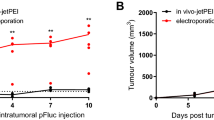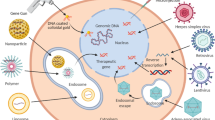Abstract
Syngeneic inoculated metastatic mammary cancers received direct intratumoral injection of a plasmid vector containing either endostatin (pEndo) with or without a suicide gene (pHSVtk), pHSVtk alone or control vector once a week for 8 weeks. We applied electrogene transfer to the tumors after each injection and administered ganciclovir (GCV) to pHSVtk-transfected mice using an osmotic minipump. Anticancer efficacy was monitored using a variety of parameters, namely tumor volume, intratumoral microvessel density and DNA synthesis, number of mice with metastasis, and number of sites of metastasis per mouse. Tumor volume was significantly lower in all therapeutic groups, with the most effective growth suppression in the pEndo+pHSVtk/GCV group. Lymph node metastasis was significantly less frequent in all therapeutic groups, whereas the multiplicity of lung metastases was significantly lower only in the pEndo and pEndo+pHSVtk/GCV groups. All therapeutic groups showed significantly lower intratumor microvessel density and DNA synthesis. The pEndo and pEndo+pHSVtk/GCV groups also showed a significant reduction in the numbers of dilated lymphatic vessels containing intralumenal tumor cells. Our data suggest that endostatin electrogene therapy alone or in combination with pHSVtk/GCV suicide gene therapy is more beneficial than suicide gene therapy alone. The observed antimetastatic activity of endostatin may be of high clinical significance in the treatment of metastatic breast cancer.
This is a preview of subscription content, access via your institution
Access options
Subscribe to this journal
Receive 12 print issues and online access
$259.00 per year
only $21.58 per issue
Buy this article
- Purchase on Springer Link
- Instant access to full article PDF
Prices may be subject to local taxes which are calculated during checkout






Similar content being viewed by others
Abbreviations
- HSVtk:
-
herpes simplex virus 1 thymidine kinase
- HUVECs:
-
human umbilical vein endothelial cells
- PI:
-
propidium iodide
- TUNEL:
-
terminal deoxynucleotidyl transferase-mediated dUTP-digoxigenin nick end-labeling
- vWF:
-
von Willebrand factor
References
Kuroishi T, Tominaga S . Epidemiol. Breast Cancer. Jpn J Cancer Chemother 2001; 28: 168–173.
Jemal A, Thomas A, Murray T, Thun M . Cancer statistics, 2002. CA Cancer J Clin 2002; 52: 23–47.
Folkman J . Angiogenesis-dependent diseases. Semin Oncol 2001; 28: 536–542.
Carmeliet P, Jain RK . Angiogenesis in cancer and other diseases. Nature 2000; 407: 249–257.
Folkman J . Antiangiogenic gene therapy. Proc Natl Acad Sci USA 1998; 95: 9064–9066.
Feldman AL, Libutti SK . Progress in antiangiogenic gene therapy of cancer. Cancer 2000; 89: 1181–1194.
Folkman J . Endogenous angiogenesis inhibitors. Apmis 2004; 112: 496–507.
O’Reilly MS, Boehm T, Shing Y, Fukai N, Vasios G, Lane WS et al. Endostatin: an endogenous inhibitor of angiogenesis and tumor growth. Cell 1997; 88: 277–285.
Korpelainen EI, Alitalo K . Signaling angiogenesis and lymphangiogenesis. Curr Opin Cell Biol 1998; 10: 159–164.
Rehn M, Veikkola T, Kukk-Valdre E, Nakamura H, Ilmonen M, Lombardo C et al. Interaction of endostatin with integrins implicated in angiogenesis. Proc Natl Acad Sci USA 2001; 98: 1024–1029.
Moolten I . Drug sensitivity (‘suicide’) genes for selective cancer therapy. Cancer Gene Ther 1994; 1: 107–112.
Culver KW, Ram Z, Wallbridge S, Ishii H, Oldfield EH, Blaese RM . In vivo gene transfer with retroviral vector-producer cells for treatment of experimental brain tumors. Science 1992; 256: 1550–1552.
Shibata MA, Morimoto J, Otsuki Y . Suppression of murine mammary carcinoma growth and metastasis by HSVtk/GCV gene therapy using in vivo electroporation. Cancer Gene Ther 2002; 9: 16–27.
Titomirov AV, Sukharev S, Kistanova E . In vivo electroporation and stable transformation of skin cells of newborn mice by plasmid DNA. Biochim Biophys Acta 1991; 1088: 131–134.
Aihara H, Miyazaki J . Gene transfer into muscle by electroporation in vivo. Nat Biotechnol 1998; 16: 867–870.
Suzuki T, Shin B, Fujikura K, Matsuzaki T, Takata K . Direct gene transfer into rat liver cells by in vivo electroporation. FEBS Lett 1998; 425: 436–440.
Harimoto K, Sugumura K, Lee C, Kuratsukuri K, Kishimoto T . In vivo gene transfer methods in the bladder without viral vectors. Br J Urol 1998; 81: 870–874.
Harrison R, Byrne BJ, Tung L . Electroporation-mediated gene transfer in cardiac tissue. FEBS Lett 1998; 435: 1–5.
Goto T, Nishi T, Tamura T, Dev SB, Takeshima H, Kochi M et al. Highly efficient electro-gene therapy of solid tumor by using an expression plasmid for the herpes simplex virus thymidine kinase gene. Proc Natl Acad Sci USA 2000; 97: 354–359.
Lohr F, Lo DY, Zaharoff DA, Hu K, Zhang X, Li Y et al. Effective tumor therapy with plasmid-encoded cytokines combined with in vivo electroporation. Cancer Res 2001; 61: 3281–3284.
Yamashita Y, Shimada M, Hasegawa H, Minagawa R, Rikimaru T, Hamatsu T et al. Electroporation-mediated interleukin-12 gene therapy for hepatocellular carcinoma in the mice model. Cancer Res 2001; 61: 1005–1012.
Shibata MA, Horiguchi T, Morimoto J, Otsuki Y . Massive apoptotic cell death in chemically induced rat urinary bladder carcinomas following in situ HSVtk electrogene transfer. J Gene Med 2003; 5: 219–231.
Shibata MA, Miwa Y, Miyashita M, Morimoto J, Abe H, Otsuki Y . Electrogene transfer of an Epstein–Barr virus-based plasmid replicon vector containing the diphtheria toxin A gene suppresses mammary carcinoma growth in SCID mice. Cancer Sci 2005; 96: 434–440.
Shibata MA, Ito Y, Morimoto J, Kusakabe K, Yoshinaka R, Otsuki Y . In vivo electrogene transfer of interleukin-12 inhibits tumor growth and lymph node and lung metastasis in mouse mammary carcinomas. J Gene Med 2006; 8: 335–352.
Morimoto J, Imai S, Haga S, Iwai Y, Iwai M, Hiroishi S et al. New murine mammary tumor cell lines. In vitro Cell Dev Biol 1991; 27A: 349–351.
Shibata MA, Ito Y, Morimoto J, Otsuki Y . Lovastatin inhibits tumor growth and lung metastasis in mouse mammary carcinoma model: a p53-independent mitochondrial-mediated apoptotic mechanism. Carcinogenesis 2004; 25: 1887–1898.
Shibata MA, Liu M-L, Knudson MC, Shibata E, Yoshidome K, Bandy T et al. Haploid loss of bax leads to accelerated mammary tumor development in C3(1)/SV40-TAg transgenic mice: reduction in protective apoptotic response at the preneoplastic stage. EMBO J 1999; 18: 2692–2701.
Gorrin-Rivas MJ, Arii S, Furutani M, Mizumoto M, Mori A, Hanaki K et al. Mouse macrophage metalloelastase gene transfer into a murine melanoma suppresses primary tumor growth by halting angiogenesis. Clin Cancer Res 2000; 6: 1647–1654.
Livak KJ, Schmittgen TD . Analysis of relative gene expression data using real-time quantitative PCR and the 2(-Delta Delta C(T)) Method. Methods 2001; 25: 402–408.
Carter CL, Allen C, Henson DE . Relation of tumor size, lymph node status, and survival in 24,740 breast cancer cases. Cancer 1989; 63: 181–187.
Kim YM, Hwang S, Pyun BJ, Kim TY, Lee ST, Gho YS et al. Endostatin blocks vascular endothelial growth factor-mediated signaling via direct interaction with KDR/Flk-1. J Biol Chem 2002; 277: 27872–27879.
Kisker O, Becker CM, Prox D, Fannon M, D’Amato R, Flynn E et al. Continuous administration of endostatin by intraperitoneally implanted osmotic pump improves the efficacy and potency of therapy in a mouse xenograft tumor model. Cancer Res 2001; 61: 7669–7674.
Mundhenke C, Thomas JP, Wilding G, Lee FT, Kelzc F, Chappell R et al. Tissue examination to monitor antiangiogenic therapy: a phase I clinical trial with endostatin. Clin Cancer Res 2001; 7: 3366–3374.
Thomas JP, Arzoomanian RZ, Alberti D, Marnocha R, Lee F, Friedl A et al. Phase I pharmacokinetic and pharmacodynamic study of recombinant human endostatin in patients with advanced solid tumors. J Clin Oncol 2003; 21: 223–231.
Klatzmann D, Valery CA, Bensimon G, Marro B, Boyer O, Mokhtari K et al. A phase I/II study of herpes simplex virus type I thymidine kinase ‘suicide’ gene therapy for recurrent glioblastoma. Hum Gene Ther 1998; 9: 2595–2604.
Sterman DH, Treat J, Litzky LA, Amin KM, Coonrod L, Molnar-Kimbe K et al. Adenovirus-mediated herpes simplex virus thymidine kinase/ganciclovir gene therapy in patients with localized malignancy: results of a phase I clinical trial in malignant mesothelioma. Hum Gene Ther 1998; 9: 1083–1092.
Shalev M, Kadmon D, Teh BS, Butler E, Aguilar-Cordova E, Thompson TC et al. Suicide gene therapy toxicity after multiple and repeat injections in patients with localized prostate cancer. J Urol 2000; 163: 1747–1750.
Kuriyama S, Kikukawa M, Masui K, Okuda H, Nakatani T, Akahane T et al. Cancer gene therapy with HSV-tk/GCV system depends on T-cell-mediated immune responses and causes apoptotic death of tumor cells in vivo. Int J Cancer 1999; 83: 374–380.
Shibata MA, Morimoto J, Ito Y, Kusakabe K, Otsuki Y . Experimental gene therapy in mammary and urinary bladder cancer using electrogene transfer. Med Electron Microsc 2004; 37: 216–224.
Colombo MP, Trinchieri G . Interleukin-12 in anti-tumor immunity and immunotherapy. Cytokine Growth Factor Rev 2002; 13: 155–168.
Nastala CL, Edington HD, McKinney TG, Tahara H, Nalesnik MA, Brunda MJ et al. Recombinant IL-12 administration induces tumor regression in association with IFN-γ production. J Immunol 1994; 153: 1697–1706.
Uesato M, Gunji Y, Tomonaga T, Miyazaki S, Shiratori T, Matsubara H et al. Synergistic antitumor effect of antiangiogenic factor genes on colon 26 produced by low-voltage electroporation. Cancer Gene Ther 2004; 11: 625–632.
Pulkkanen KJ, Laukkanen JM, Fuxe J, Kettunen MI, Rehn M, Kannasto JM et al. The combination of HSV-tk and endostatin gene therapy eradicates orthotopic human renal cell carcinomas in nude mice. Cancer Gene Ther 2002; 9: 908–916.
Abdollahi A, Lipson KE, Sckell A, Zieher H, Klenke F, Poerschke D et al. Combined therapy with direct and indirect angiogenesis inhibition results in enhanced antiangiogenic and antitumor effects. Cancer Res 2003; 63: 8890–8898.
Salven P, Lymboussaki A, Heikkila P, Jaaskela-Saari H, Enholm B, Aase K et al. Vascular endothelial growth factors VEGF-B and VEGF-C are expressed in human tumors. Am J Pathol 1998; 153: 103–108.
Valtola R, Salven P, Heikkila P, Taipale J, Joensuu H, Rehn M et al. VEGFR-3 and its ligand VEGF-C are associated with angiogenesis in breast cancer. Am J Pathol 1999; 154: 1381–1390.
Kaipainen A, Korhonen J, Mustonen T, van Hinsbergh VW, Fang GH, Dumont D et al. Expression of the fms-like tyrosine kinase 4 gene becomes restricted to lymphatic endothelium during development. Proc Natl Acad Sci USA 1995; 92: 3566–3570.
Brockstedt DG, Diagana M, Zhang Y, Tran K, Belmar N, Meier M et al. Development of anti-tumor immunity against a non-immunogenic mammary carcinoma through in vivo somatic GM-CSF, IL-2, and HSVtk combination gene therapy. Mol Ther 2002; 6: 627–636.
Cichon T, Jamrozy L, Glogowska J, Missol-Kolka E, Szala S . Electrotransfer of gene encoding endostatin into normal and neoplastic mouse tissues: inhibition of primary tumor growth and metastatic spread. Cancer Gene Ther 2002; 9: 771–777.
Acknowledgements
We thank Deborah E Devor-Henneman for critical review of the paper and Ms Hidemi Hiyama for warm-hearted secretarial assistance. This investigation was supported, in part, by the Development of Characteristic Education Grant from the Japan Private School Promotion Foundation (to MA Shibata), with main support from a Grant-in-Aid for Scientific Research (C)(2) from the Ministry of Education, Culture, Sports, Science and Technology of Japan (No. 15591368 to MA Shibata) and from a High-Tech Research Center Grant to Osaka Medical College from the Ministry of Education, Culture, Sports, Science and Technology of Japan.
Author information
Authors and Affiliations
Corresponding author
Rights and permissions
About this article
Cite this article
Shibata, MA., Morimoto, J., Doi, H. et al. Electrogene therapy using endostatin, with or without suicide gene therapy, suppresses murine mammary tumor growth and metastasis. Cancer Gene Ther 14, 268–278 (2007). https://doi.org/10.1038/sj.cgt.7701009
Received:
Revised:
Accepted:
Published:
Issue Date:
DOI: https://doi.org/10.1038/sj.cgt.7701009
Keywords
This article is cited by
-
The endogenous soluble VEGF receptor-2 isoform suppresses lymph node metastasis in a mouse immunocompetent mammary cancer model
BMC Medicine (2010)
-
Combination therapy with short interfering RNA vectors against VEGF-C and VEGF-A suppresses lymph node and lung metastasis in a mouse immunocompetent mammary cancer model
Cancer Gene Therapy (2008)
-
Antimetastatic effect of suicide gene therapy for mouse mammary cancers requires T-cell-mediated immune responses
Medical Molecular Morphology (2008)
-
Combined effects of radiotherapy and endostatin gene therapy in melanoma tumor model
Radiation and Environmental Biophysics (2008)
-
Endostatin gene therapy enhances the efficacy of paclitaxel to suppress breast cancers and metastases in mice
Journal of Biomedical Science (2008)



